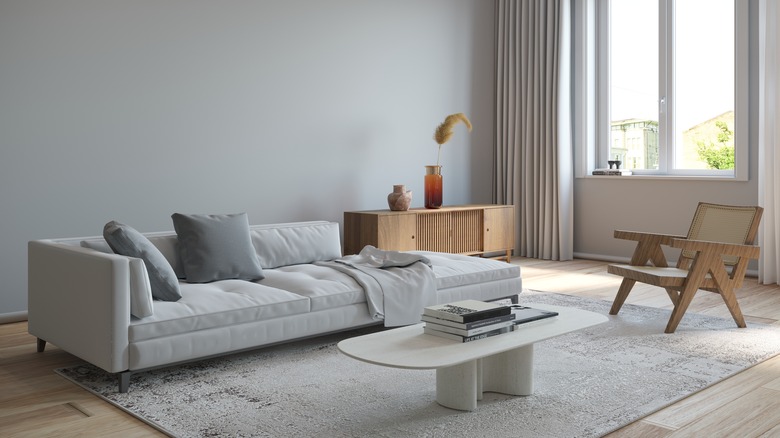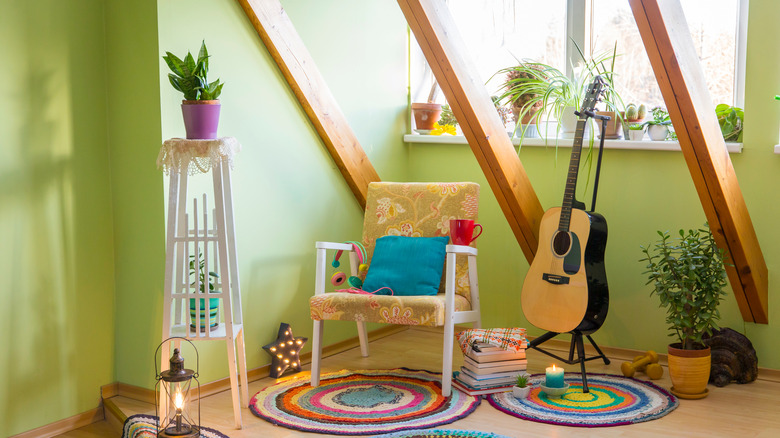The Biggest Differences Between Gen Z And Millennial Home Decor Trends
Though it's defined differently depending on what you read or who you speak to, the millennial generation is generally thought to have begun in 1981 and finished in 1996, and Generation Z began in 1997 and finished in 2012, meaning the youngest millennial would be born in 1996 and the oldest Generation Zer in 1997. There is some crossover in-between the generations (Zillenials, anyone?), but the above years are usually accepted. Though the generations directly follow each other, they differ in several things, and one of these things is how they like to decorate.
From minimalism to maximalism, keeping an eye out for sustainability on all fronts, and the differences in chosen color palettes, there are some decor areas where there's a clear and obvious difference between millennials and Generation Z (otherwise known as Gen Z). If you have wondered what the design differences between you and your older sibling or friends (or the other way round) are, below are the most obvious discrepancies between the generational decorating styles.
The two generations appear to have opposite tastes in home decor
As mentioned, one of the major differences between Gen Z and millennials is minimalism versus maximalism. While millennials lean towards minimalism in the way they decorate, Gen Zers tend to favor bold, bright colors and shapes. There's even a name for the color millennials apparently go towards the most — "millennial gray." While the actual origins of this term aren't known, the name coupled with the understated color palette of minimalism definitely makes sense. Speaking to Livingetc, interior designer Kelly Kruger shared that millennial home decor is "heavily influenced by mid-century modern and minimalist Scandi, with simple lines and a utilitarian no-frills kind of clean look."
As for colors, Kruger confirmed the "millennial gray" obsession, revealing, "Millennials gravitated toward neutral color palettes heavy in cool grey tones, white and bright airy spaces." On the other hand, Gen Zers (mostly) seem to lean toward the weird and wonderful — basically, if something makes them happy, it's going in the house. Splashes of various colors coupled with flower-shaped lamps and large rugs make up what is essentially a maximalist paradise. If you want to incorporate maximalism into your home, simply buy what feels good and let your heart lead your decor style.
Sustainability is playing a major part in Gen Z's design picks
In addition to minimalism versus maximalism, millennials and Gen Z also differ when it comes to sustainable interior decor. While millennials are more likely to do their research and pay a little extra where possible for pieces that have less of an impact on the environment, Gen Z are willing to get stuck in and customize existing furniture pieces. Whether it's a random dresser found on the side of the street or an upholstered IKEA sofa, the latter generation make every furniture piece their own. Finally, there are clear differences in the colors each generation gravitates toward.
Fitting in with their maximalist tendencies, Gen Zers are fans of colors that evoke happiness, namely bold blues, cheerful yellow, and bright pink shade. They incorporate color with ease and aren't afraid to add in-your-face patterns like checks in their decor. Conversely, millennials are more cautious with color. As well as gray, they prefer to stick with darker neutrals like black, though they do also have a fondness for blue. Overall, Gen Z favors finding old things and making them fit their aesthetic with bold strokes, whereas millennials are more likely to prefer a calm, uncluttered space with a neutral palette and small pops of color.



